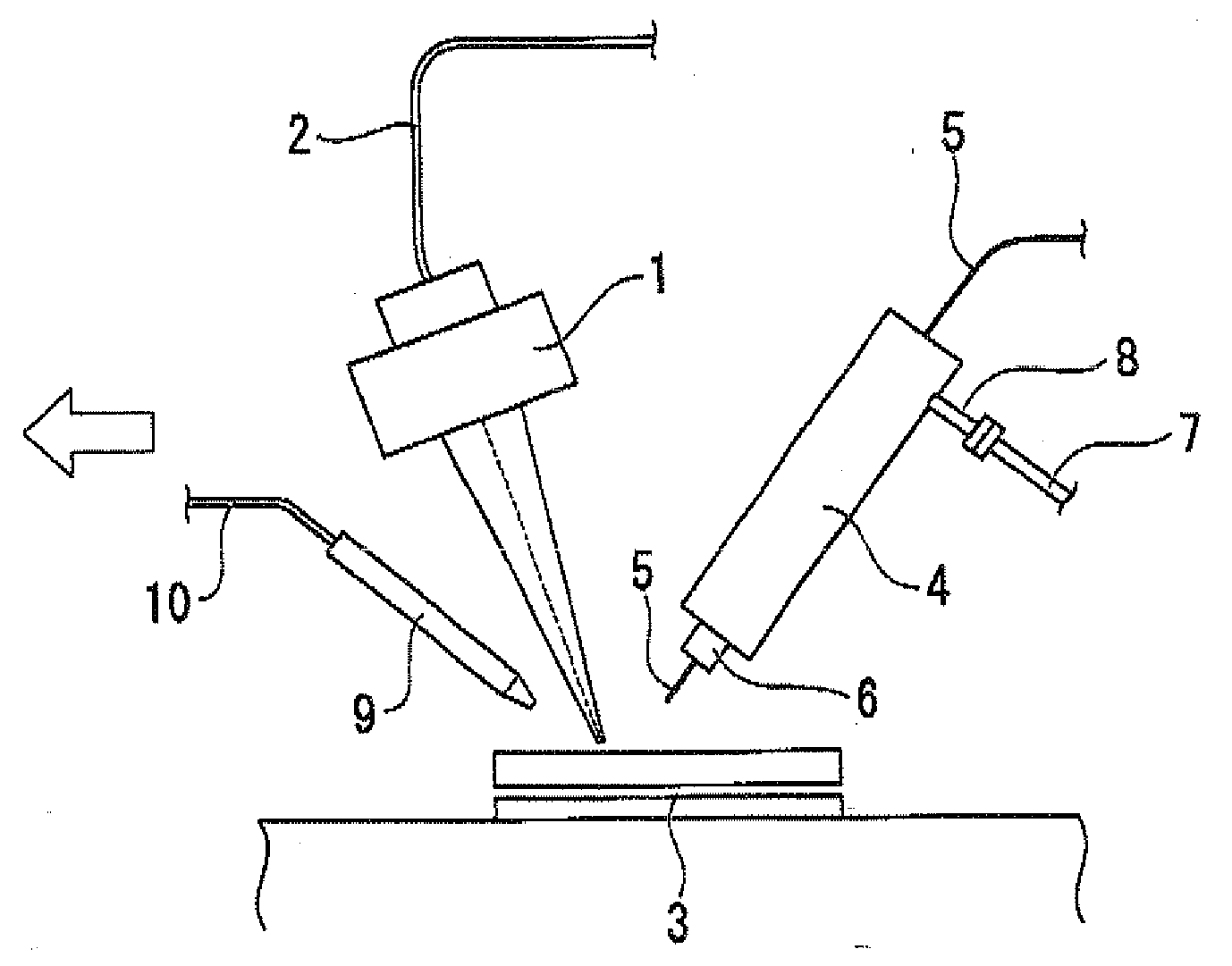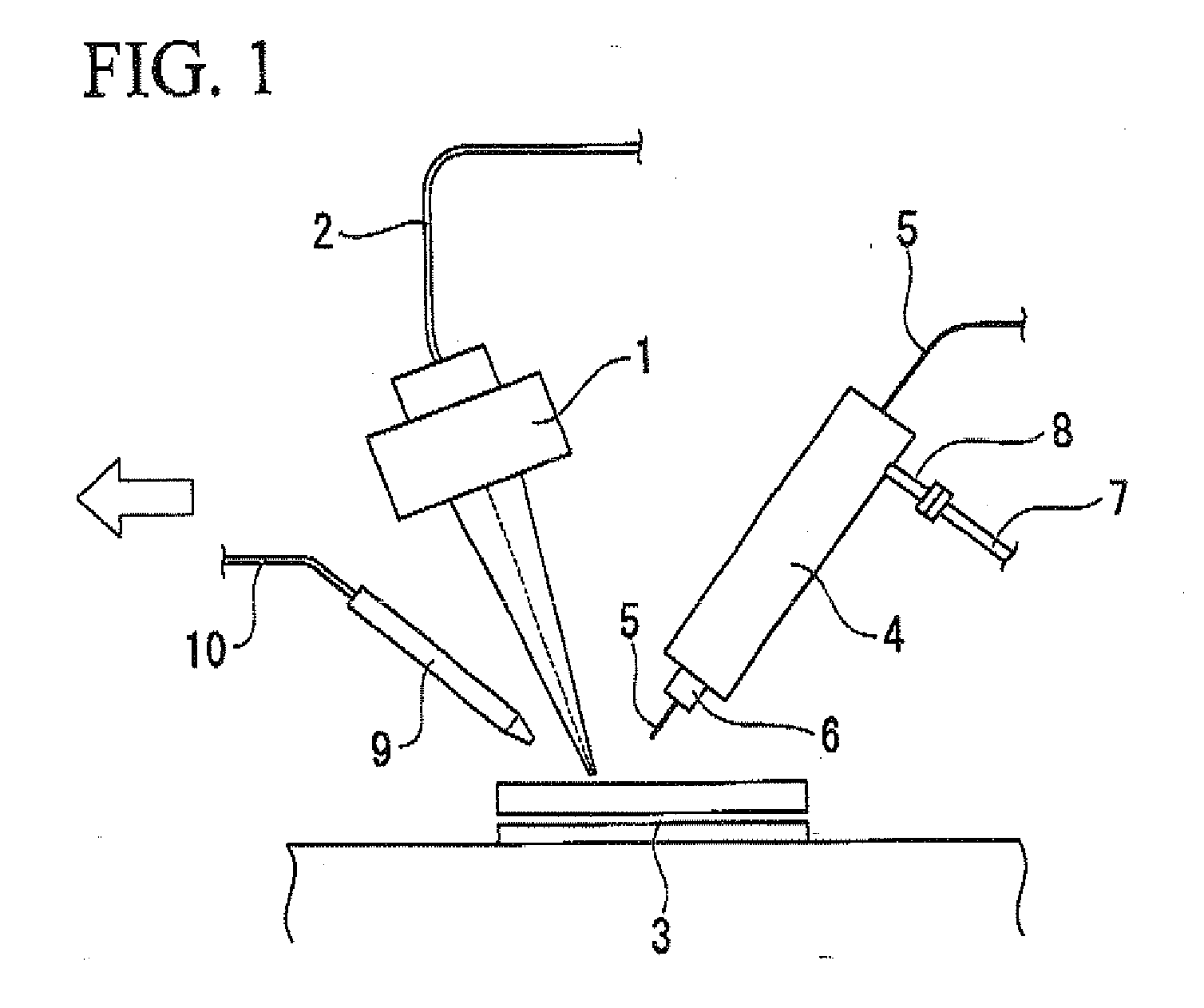Shielding gas for hybrid welding and hybrid welding method using the same
a hybrid welding and shielding gas technology, applied in welding/cutting media/materials, welding apparatus, manufacturing tools, etc., can solve the problems of insufficient welding, high cost of shielding gas, and inability to alleviate generated defects, so as to achieve excellent wettability, reduce shielding properties, and prevent pit generation
- Summary
- Abstract
- Description
- Claims
- Application Information
AI Technical Summary
Benefits of technology
Problems solved by technology
Method used
Image
Examples
examples
[0114]Hereinafter, the present invention will be further described in detail with reference to Examples.
(Hybrid Welding of a Lapped Joint of a Galvannealed Steel Plate)
[0115]Hybrid welding was conducted using a shielding gas and a welding machine shown in FIG. 1.
[0116]Welding was conducted with respect to a lap joint where steel plates were piled under the following conditions. The shielding gas was supplied from an arc torch. An alloyed hot dip galvannealed steel plate (the zinc coating weight thereof was 45 g / m2) 0.7 mm thick or 0.8 mm thick, and a cold-reduced steel sheet 1.0 mm thick were used as the welded materials. A three-component-mixed gas including an argon gas, an oxygen gas, and a carbon dioxide gas was used as the shielding gas. These components were mixed at different ratios to produce a plurality of shielding gases having different compositions. Additionally, a case where a gap was provided between steel plates and a case where a gap was not provided therein were als...
experiment 4
(Experiment 4)
[0179]Using two galvannealed steel plates 1.8 mm thick, lap fillet welding was conducted where the gap between the upper and lower plates was 0 mm and the push angle of the arc torch was 20°. The number of pits in a weld length of 100 mm, the presence of bead irregularities where a continuous bead could not be formed due to occurrence of humping or the like, and generation of spatters were confirmed. A three-component mixed gas including an argon gas, a carbon dioxide gas and an oxygen gas was used as the shielding gas, and hybrid welding was conducted while modifying the compositional ratio of the carbon dioxide gas and the oxygen gas in the shielding gas.
[0180]Additionally, comparative examples using an argon gas-carbon dioxide gas-based shielding gas and an argon gas-oxygen gas-based shielding gas that are general shielding gases for MAG welding are shown below.
[0181]When bead irregularities were not present in welded samples, the center of the bead thereof was cut ...
experiment 5
(Experiment 5)
[0210]Using a cold-reduced steel sheet 1.2 mm thick as a upper plate and a galvannealed steel plate 1.6 mm thick as a lower plate, lap fillet welding was conducted where the gap between the upper and lower plates was 0 mm and the push angle of the arc torch was 20°. In the same manner as Experiment 4, the number of pits in a weld length of 100 mm, presence of bead irregularities where a continuous bead could not be formed due to occurrence of humping or the like, and generation of spatters was confirmed.
[0211]A three-component mixed gas including an argon gas, a carbon dioxide gas and an oxygen gas was used as the shielding gas, and hybrid welding was conducted while modifying the compositional ratio of the carbon dioxide gas and the oxygen gas in the shielding gas. Additionally, an Ar—CO2-based shielding gas and an Ar—O2-based shielding gas that are general shielding gases for MAG welding were used as comparative experiments.
[0212]When bead irregularities were not pre...
PUM
| Property | Measurement | Unit |
|---|---|---|
| melting point | aaaaa | aaaaa |
| melting point | aaaaa | aaaaa |
| wavelength | aaaaa | aaaaa |
Abstract
Description
Claims
Application Information
 Login to View More
Login to View More - R&D
- Intellectual Property
- Life Sciences
- Materials
- Tech Scout
- Unparalleled Data Quality
- Higher Quality Content
- 60% Fewer Hallucinations
Browse by: Latest US Patents, China's latest patents, Technical Efficacy Thesaurus, Application Domain, Technology Topic, Popular Technical Reports.
© 2025 PatSnap. All rights reserved.Legal|Privacy policy|Modern Slavery Act Transparency Statement|Sitemap|About US| Contact US: help@patsnap.com



